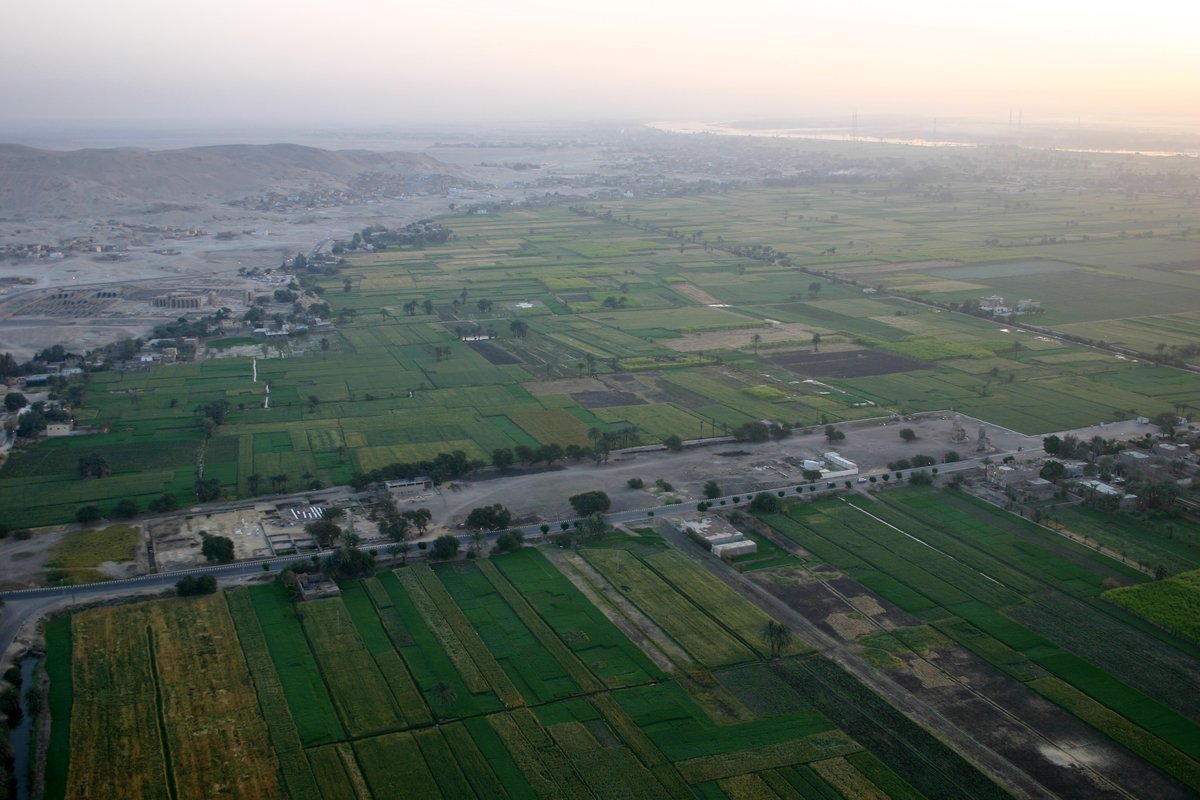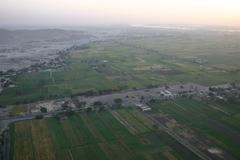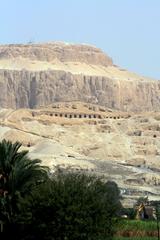
Visiting the Mortuary Temple of Nebhepetre Amenhotep III in Luxor, Egypt
Date: 18/07/2024
Overview of the Mortuary Temple of Nebhepetre Amenhotep III
The Mortuary Temple of Nebhepetre Amenhotep III, also known as Kom el-Hettan, is a monumental testament to the grandeur and ambition of one of ancient Egypt’s most powerful pharaohs. Located on the west bank of the Nile River in Luxor, this sprawling complex was a marvel of architecture and artistry dedicated to the cult of the deceased king and the sun god Amun-Re (source). Constructed during the reign of Amenhotep III, the ninth pharaoh of the Eighteenth Dynasty, the temple complex covered an estimated area of 350,000 square meters and was designed to be a place of worship for Amenhotep III’s spirit after his death. The temple’s grand scale and lavish decorations reflect the immense power and wealth of Amenhotep III and the Eighteenth Dynasty, setting a standard for royal architecture in the New Kingdom. Despite its ruinous state today, the temple remains a significant historical site, offering valuable insights into ancient Egyptian religious beliefs, artistic conventions, and architectural innovations.
Contents
- Introduction
- Historical Background and Significance
- Amenhotep III - The Pharaoh Behind the Monument
- A Temple Fit for a God-King
- Architectural Splendor and Artistic Masterpieces
- The Temple’s Decline and Rediscovery
- Significance of the Temple
- Visitor Information
- Visiting Hours and Tickets
- Travel Tips
- Nearby Attractions
- Accessibility
- Guided Tours and Photography
- FAQs
- Conclusion
Introduction
The Mortuary Temple of Nebhepetre Amenhotep III, also known as Kom el-Hettan, stands as a testament to the grandeur and ambition of one of ancient Egypt’s most powerful pharaohs. Located on the west bank of the Nile River in Luxor, this sprawling complex was once a marvel of architecture and artistry, dedicated to the cult of the deceased king and the sun god Amun-Re. This article will explore the historical background, architectural splendor, and practical visitor information for those planning a trip to this magnificent site.
Historical Background and Significance
Amenhotep III - The Pharaoh Behind the Monument
Amenhotep III, the ninth pharaoh of the Eighteenth Dynasty, ruled Egypt from approximately 1386 to 1353 BCE. His reign marked a period of unprecedented peace, prosperity, and artistic flourishing. Known for his diplomatic skills and love for lavish building projects, Amenhotep III commissioned numerous temples, palaces, and monuments throughout Egypt, with his mortuary temple being one of the most ambitious.
A Temple Fit for a God-King
The temple complex, covering an estimated area of 350,000 square meters, was designed to be a place of worship for Amenhotep III’s spirit after his death. It also served as a celebration of his reign and a statement of his divine power. The temple’s layout followed the traditional plan of New Kingdom mortuary temples, with a processional route leading through a series of courtyards, pylons, and halls to the inner sanctuaries.
Architectural Splendor and Artistic Masterpieces
The temple was renowned for its colossal statues, intricate reliefs, and vibrant paintings. At its entrance stood two massive quartzite statues of Amenhotep III, known as the Colossi of Memnon, which once guarded the temple’s first pylon. These awe-inspiring statues, each weighing over 700 tons, are still standing today, albeit heavily weathered by time and the elements.
Inside the temple, visitors would have been greeted by a dazzling array of decorations. The walls were adorned with intricate reliefs depicting scenes from Amenhotep III’s reign, religious rituals, and the journey of the sun god through the underworld. The ceilings were painted with vibrant colors and intricate patterns, while the floors were paved with polished stone.
The Temple’s Decline and Rediscovery
Following Amenhotep III’s death, his mortuary temple continued to be used for religious ceremonies for several centuries. However, like many ancient Egyptian monuments, it eventually fell into disrepair due to the combined effects of time, natural disasters, and human activity. The temple was buried under layers of sand and silt, its once-grand structures reduced to ruins.
In the 19th century, European explorers rediscovered the site and began excavating the buried temple. Their efforts revealed the temple’s impressive scale and the beauty of its surviving decorations. Today, the Mortuary Temple of Nebhepetre Amenhotep III is a UNESCO World Heritage Site and a popular tourist destination, offering a glimpse into the splendor of ancient Egypt.
Significance of the Temple
The Mortuary Temple of Nebhepetre Amenhotep III holds immense historical and cultural significance for several reasons:
- A Testament to Royal Power: The temple’s grand scale and lavish decorations reflect the immense power and wealth of Amenhotep III and the Eighteenth Dynasty. It served as a symbol of the pharaoh’s divine authority and his close relationship with the gods.
- Architectural Innovation: The temple’s design and layout influenced later mortuary temples built by subsequent pharaohs. Its use of colossal statues, intricate reliefs, and vibrant paintings set a standard for royal architecture in the New Kingdom.
- Religious Beliefs and Practices: The temple’s decorations provide valuable insights into ancient Egyptian religious beliefs and practices, particularly those related to the afterlife, the cult of the sun god, and the role of the pharaoh as an intermediary between the human and divine realms.
- Artistic Legacy: The surviving statues, reliefs, and paintings from the temple are considered masterpieces of ancient Egyptian art. They showcase the skill and artistry of the craftsmen who created them and provide valuable information about the artistic conventions and techniques of the time.
Visitor Information
Visiting Hours and Tickets
The Mortuary Temple of Amenhotep III is open daily from 6:00 AM to 5:00 PM. Tickets can be purchased at the entrance or online through the official site. It is advisable to check visiting hours and ticket prices beforehand, as they may vary based on the season or special events.
Travel Tips
- Best Time to Visit: The best time to visit Luxor and the Mortuary Temple is during the cooler months between October and April.
- How to Get There: The temple is located on the west bank of the Nile in Luxor. It can be reached by taxi, local bus, or organized tour. Some visitors also opt to take a scenic boat ride across the Nile.
- What to Wear: Comfortable clothing and shoes are recommended. Don’t forget a hat, sunglasses, and sunscreen to protect yourself from the sun.
Nearby Attractions
- Valley of the Kings: Home to the tombs of pharaohs including Tutankhamun.
- Luxor Temple: Another magnificent temple complex located on the east bank of the Nile.
- Karnak Temple: One of the largest temple complexes in Egypt, dedicated to the Theban triad of Amun, Mut, and Khonsu.
Accessibility
While the site is partially accessible, some areas may be challenging for individuals with mobility issues. It is recommended to check accessibility options and any special arrangements in advance.
Guided Tours and Photography
Guided tours are available and highly recommended to gain deeper insights into the temple’s history and significance. Photography is allowed, but some areas may have restrictions, so it’s best to inquire on-site.
FAQs
What are the Mortuary Temple of Amenhotep III visiting hours?
The temple is open daily from 6:00 AM to 5:00 PM.
How can I purchase tickets for the Mortuary Temple?
Tickets can be purchased at the entrance or online through the official site.
Are there guided tours available?
Yes, guided tours are available and highly recommended.
What are some nearby attractions?
Nearby attractions include the Valley of the Kings, Luxor Temple, and Karnak Temple.
Conclusion
The Mortuary Temple of Nebhepetre Amenhotep III is not just a collection of ruins but a window into a glorious past. It stands as a testament to the ambition, artistry, and religious beliefs of one of ancient Egypt’s most remarkable periods. A visit to this awe-inspiring site offers a unique opportunity to connect with history and experience the grandeur of a bygone era.
Stay up to date by following our social media channels and downloading the Audiala mobile app for more interesting articles and updates about historical sites like the Mortuary Temple of Amenhotep III.
Summary and Key Takeaways
The Mortuary Temple of Nebhepetre Amenhotep III stands as a remarkable window into ancient Egypt’s glorious past. Despite the toll of time, natural disasters, and human activity, the temple’s remains continue to captivate visitors with their grandeur and historical significance (source). The temple serves as a testament to the ambition, artistry, and religious beliefs of one of ancient Egypt’s most remarkable periods. A visit to this awe-inspiring site offers a unique opportunity to connect with history and experience the architectural and artistic achievements of the New Kingdom (source). Whether you are a history enthusiast, an architecture aficionado, or a casual traveler, the Mortuary Temple of Amenhotep III provides an enriching journey through time, showcasing the enduring legacy of one of Egypt’s most powerful pharaohs (source).

































































